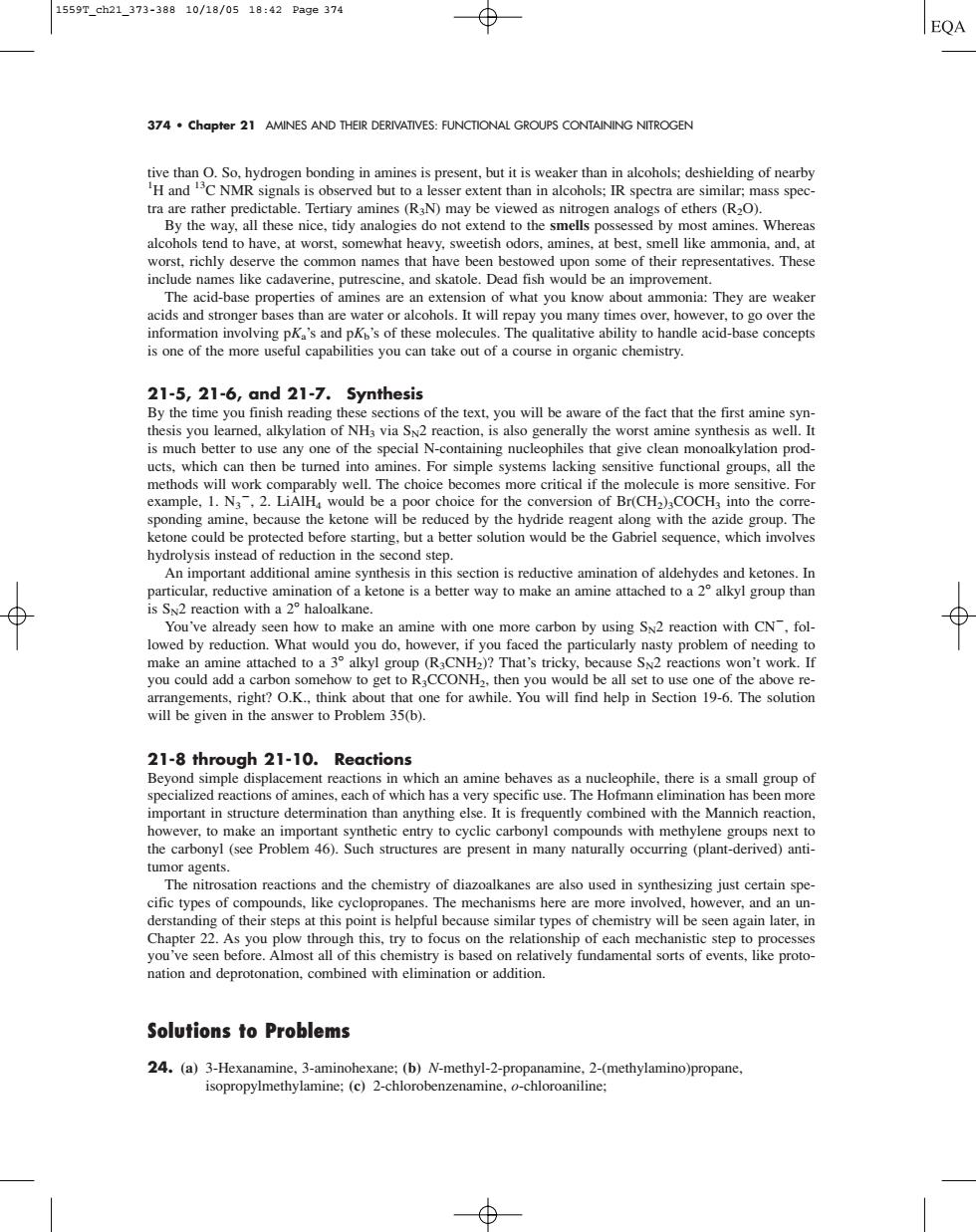正在加载图片...

1559Tch21373-38810/18/0518:42Page374 EQA 374.chapter 21 AMINES AND THEIR DERIVATIVES:FUNCTIONAL GROUPS CONTAINING NITROGEN gen b mines is present ass spec tra are rather predic able.Tertiary amines(R3N)may be vie d as nitrogen analog s of ethers (Ro) y the way thes nice,tidy analogies do not exte he sme s po by st amines.Wl worst,richly deserve the common names that have been bestowed upon some of their representatives.These include names like cadaverine,putrescine.and skatole.Dead fish wo ld be an improvem acids and st y are wea pof moecu The qualitative tohandle acid-base is one of the more useful capabilities you can take out of a course in organic chemistry 21-5,21-6,and21-7.5 ynthesis can then be tu nines.For simple systems example,1.N2.LiAH would be a poor choice for the conversion of Br(CH)COCH into the cor reduced by hvdrolysis instead of reduction in he An important additional amine synthesis in this section is reductive amination of aldehydes and ketones.Ir a ketone is a better way to make an amine attached to a 2 alkyl group tha You've already seen how to make an amine with one more carbon by using S2 reaction with CN.fol- lowed by reduction.Wh t wou d you do.how aced th particularly 21-8 thro ugh 21-10.Reactions important in structure determination than anything else.It is frequently combined with the Mannich reaction tumor agents. he nitrosation reaction Chapter 22.A uson the relation nation and deprotontio combined with elimination or addition. Solutions to Problems 24.(a)3-Hexanamine,3-aminohexane:(b)N-methyl-2-propanamine.2-(methylamino)propane isopropylmethylamine:(c)2-chlorobenzenamine,o-chloroaniline:374 • Chapter 21 AMINES AND THEIR DERIVATIVES: FUNCTIONAL GROUPS CONTAINING NITROGEN tive than O. So, hydrogen bonding in amines is present, but it is weaker than in alcohols; deshielding of nearby 1 H and 13C NMR signals is observed but to a lesser extent than in alcohols; IR spectra are similar; mass spectra are rather predictable. Tertiary amines (R3N) may be viewed as nitrogen analogs of ethers (R2O). By the way, all these nice, tidy analogies do not extend to the smells possessed by most amines. Whereas alcohols tend to have, at worst, somewhat heavy, sweetish odors, amines, at best, smell like ammonia, and, at worst, richly deserve the common names that have been bestowed upon some of their representatives. These include names like cadaverine, putrescine, and skatole. Dead fish would be an improvement. The acid-base properties of amines are an extension of what you know about ammonia: They are weaker acids and stronger bases than are water or alcohols. It will repay you many times over, however, to go over the information involving pKa’s and pKb’s of these molecules. The qualitative ability to handle acid-base concepts is one of the more useful capabilities you can take out of a course in organic chemistry. 21-5, 21-6, and 21-7. Synthesis By the time you finish reading these sections of the text, you will be aware of the fact that the first amine synthesis you learned, alkylation of NH3 via SN2 reaction, is also generally the worst amine synthesis as well. It is much better to use any one of the special N-containing nucleophiles that give clean monoalkylation products, which can then be turned into amines. For simple systems lacking sensitive functional groups, all the methods will work comparably well. The choice becomes more critical if the molecule is more sensitive. For example, 1. N3 , 2. LiAlH4 would be a poor choice for the conversion of Br(CH2)3COCH3 into the corresponding amine, because the ketone will be reduced by the hydride reagent along with the azide group. The ketone could be protected before starting, but a better solution would be the Gabriel sequence, which involves hydrolysis instead of reduction in the second step. An important additional amine synthesis in this section is reductive amination of aldehydes and ketones. In particular, reductive amination of a ketone is a better way to make an amine attached to a 2° alkyl group than is SN2 reaction with a 2° haloalkane. You’ve already seen how to make an amine with one more carbon by using SN2 reaction with CN, followed by reduction. What would you do, however, if you faced the particularly nasty problem of needing to make an amine attached to a 3° alkyl group (R3CNH2)? That’s tricky, because SN2 reactions won’t work. If you could add a carbon somehow to get to R3CCONH2, then you would be all set to use one of the above rearrangements, right? O.K., think about that one for awhile. You will find help in Section 19-6. The solution will be given in the answer to Problem 35(b). 21-8 through 21-10. Reactions Beyond simple displacement reactions in which an amine behaves as a nucleophile, there is a small group of specialized reactions of amines, each of which has a very specific use. The Hofmann elimination has been more important in structure determination than anything else. It is frequently combined with the Mannich reaction, however, to make an important synthetic entry to cyclic carbonyl compounds with methylene groups next to the carbonyl (see Problem 46). Such structures are present in many naturally occurring (plant-derived) antitumor agents. The nitrosation reactions and the chemistry of diazoalkanes are also used in synthesizing just certain specific types of compounds, like cyclopropanes. The mechanisms here are more involved, however, and an understanding of their steps at this point is helpful because similar types of chemistry will be seen again later, in Chapter 22. As you plow through this, try to focus on the relationship of each mechanistic step to processes you’ve seen before. Almost all of this chemistry is based on relatively fundamental sorts of events, like protonation and deprotonation, combined with elimination or addition. Solutions to Problems 24. (a) 3-Hexanamine, 3-aminohexane; (b) N-methyl-2-propanamine, 2-(methylamino)propane, isopropylmethylamine; (c) 2-chlorobenzenamine, o-chloroaniline; 1559T_ch21_373-388 10/18/05 18:42 Page 374